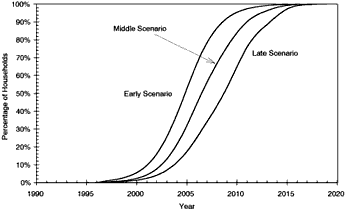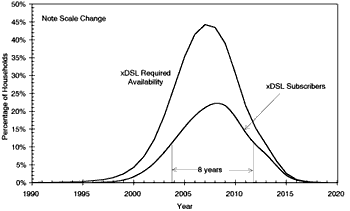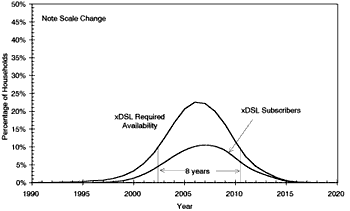
Source: Technology Futures, Inc.
Fiber-in-the-Loop (FITL)--Any of several technologies that extend fiber optics very close to the customer. The last link, up to about 1,000 feet in length, may be provided on copper pairs (e.g., xDSL), coaxial cable, fiber, or wireless technology.
Digital Subscriber Line (xDSL)--This is a family of technologies that provides high-speed digital services on the twisted pair copper cable used by LECs. ADSL is a version of this technology that provides asymmetrical service to homes with downstream bandwidths of 1.5 Mb/s to 6 Mb/s. Other versions will be able to deliver rates of up to 52 Mb/s, but only over short distances; at these rates, xDSL is really a version of FITL.
FITL requires very substantial infrastructure investment by LECs, but offers practically unlimited bandwidth, as well as intrinsic cost, technical, and operational advantages over its competitors which includes xDSL copper cable. The advantage of xDSL lies in its applicability on existing copper cable rather than on any intrinsic operational or cost benefits. Thus, LECs have choices regarding fiber and xDSL that involve the balancing of short-term and long-term considerations. The three scenarios are based on the forecasts described in the companion article; each reflects a different mid- to long-range LEC strategy. (Most, if not all, LECs will deploy xDSL, especially ASDL, in the short term.)
The "Early Scenario" assumes no use of xDSL, the "Late Scenario" assumes maximum use, and the "Middle Scenario" assumes a transitional strategy over time between minimal and maximum use of xDSL. All three scenarios envision the ultimate adoption of fiber; the only difference is in the timing. Consequently, the scenario labels refer to the timing of FITL adoption.
The late scenario assumes maximum use of xDSL, subject to the loop length limitations shown in Figure 4 in the companion article. The combination of the approximate distribution of loop lengths and the xDSL loop-length limitations imply that, under the late scenario, about 20% of 1.5 Mb/s subscribers, 50% of 6 Mb/s subscribers, and 87.5% of 24 Mb/s subscribers would need to be served on FITL; the remainder are assumed to be served on copper-based xDSL systems.2 For 100 Mb/s, the late scenario assumes 100% FITL. Although, our nominal 100 Mb/s category includes 52 Mb/s xDSL, with a maximum length of 1,000 feet on copper, xDSL at this rate qualifies under our definition of FITL. Further, because of the topology of the distribution network, the average length of copper will likely be much less--in some cases, the distance from the pedestal to the home. Finally, as data rates of 100 Mb/s or above become representative of this category, xDSL applicability will be further decreased.
Figure 1: Home Digital Service Availability on Fiber

Source: Technology Futures, Inc.
The late scenario is indicated by the right-hand line in Figure 1. It was derived by taking the weighted average of the above FITL percentages for each year, weighted by the percentage of households demanding each nominal data rate as shown in Figure 4 in the companion article. The late scenario requires that telephone companies convert about 35% of their distribution network to fiber by 2007, about half of what is required under the early scenario.
Figure 2: xDSL Households--Late Scenario

Source: Technology Futures, Inc.
Figure 2 shows the percentage of households served by xDSL, as well as the required availability for the late scenario. Under this scenario, xDSL usage peaks at over 20% of households in the 2008 timeframe. At that time, LECs would have to have xDSL available to about 45% of households.
The middle scenario assumes a mixed strategy that most resembles the late scenario in the early years and the early scenario in the later years. This maximizes the value of xDSL in providing service to customers, but allows LECs to avoid massive fiber infrastructure investments when penetration levels are relatively low. It maximizes the value of fiber later when penetration levels make such fiber infrastructure investments easier to justify. This principle is implemented in the derivation of the middle scenario by calculating a weighted average of the early and middle scenarios, with weights of 20% and 80%, respectively, in 1999, transitioning to equal weights in 2005, and weights of 80% and 20%, respectively, in 2015. As shown by the middle line in Figure 1, this scenario requires LECs to convert 56% of their distribution copper to fiber by 2007.
Figure 3: xDSL Households--Middle Scenario

Source: Technology Futures, Inc.
Figure 3 shows the percentage of households served by xDSL as well as the required availability for the "middle" scenario. Under this scenario, xDSL usage peaks at about 10% in the 2007 timeframe. At that time, LECs would have to have xDSL available to roughly 20% of households.
As we have discussed, the choice among the three scenarios boils down to the strategic role of xDSL in the mid- to long term. Referring back to Figures 2 and 3, it is not clear whether for either the middle or late scenarios there is sufficient time to fully recover the investment in xDSL technology before the ultimate adoption of fiber. For either scenario, the average xDSL investment will be placed in 2003 or 2004 and retired in 2011 or 2012, leading to an eight-year average service life for xDSL as a class. Eight years is reasonable for this type of telecommunications equipment, but the actual life may be somewhat less given the need to transition from one xDSL speed to the next. Also, deploying xDSL often requires significant rehabilitation of existing copper facilities, and assumed service lives for outside plant generally exceed eight years.
Although these concerns are not particularly important for xDSL equipment placed in the next five years or so, they become quite important for equipment placed thereafter. In the late scenario, over 15% of access lines would be provisioned with xDSL between 2002 and 2007 while, in the middle scenario, about 5% would be provisioned in the same period. During this period, high-speed digital subscribership will likely increase from under 10% of households to about 40%--subscribership levels where FITL-based systems prove-in and will provide competitive advantages to those companies deploying them. Thus, the wisdom of deploying a soon-to-be obsolete technology at the levels implied by the late scenario during the 2002-2007 period is very questionable. Put another way, if LECs follow the late scenario, they will place massive investments in upgrading to xDSL only to find, in 2007, that they are competing in a fiber world with a distribution network that is still 70% copper. For this reason, we believe the middle scenario is more likely and desirable than the late scenario for companies that pursue an xDSL-oriented strategy.
With the inherent difficulties of managing the distance limitations of xDSL in an environment where the minimum competitive bandwidth is doubling every two years, some companies will decide to minimize their use of copper-based xDSL and adopt FITL somewhat closer to the early scenario. Properly engineered, FITL provides sufficient bandwidth (or potential bandwidth) to meet the projected requirements for several decades. Further, companies following the early scenario will obtain the other benefits of FITL sooner. The main problem with the early scenario is uncertainty about which FITL architecture is best, and consensus is still several years away. The solution is to adopt flexible architectures that can be migrated or upgraded as future developments warrant.
Based on the above discussion, I believe that most LECs will follow a path of FITL adoption between the early and middle scenarios. Regardless of their short-term plans, these companies will make some use of copper-based xDSL, but not to the extent that would over-commit them to an obsolete copper network over the long run. Based on any number of factors--including competitive pressures, demographics, geography, mix of aerial and buried cable, corporate culture, regulatory environment, and growth--some companies will adopt FITL earlier or later.